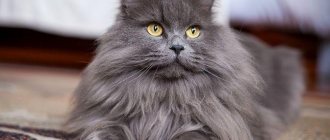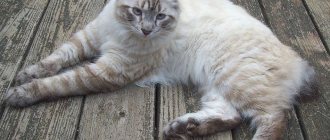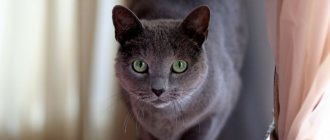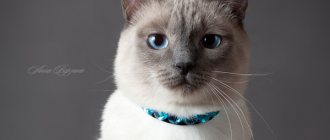In cat colors, white is presented in different variations from minimal, in the form of single hairs, “slippers”, “tie” to a completely white animal. Externally, only the area of its distribution is assessed.
The presence of white depends on the influence of three different genes, which do not necessarily have to be present simultaneously in the animal. At its core, it is not a color; it is more correct to talk about its absence or camouflage. In other words, white does not allow the main color to appear or the animal completely lacks pigment.
For a correct understanding, you need to know about the fundamental genetic differences between white cats. Completely white cats have a dominant white gene in their genotype, which prevents the main color from appearing. If an animal has white from single spots to almost complete color with colored areas, then this is due to the white spotting gene. Albinism, or the complete absence of pigment, is influenced by a gene that distributes color throughout the animal's body. Three different genes are located in different loci and have their own characteristics of external manifestation.
The dominant white and white spotting gene are located in a different locus in relation to the genes for black or red colors, therefore they are epistatic
.
They manifest themselves according to the principle of epistasis
, when a dominant or recessive gene affects another dominant one located in a different locus and completely or partially overlaps it. The albinism gene is recessive and manifests itself only in the homozygous recessive genotype.
Why is a cat born white?
Three genes are responsible for the purity of the snow cat color - albinism “c”, white color W and piebaldity S.
- From a scientific point of view, an albino cat is completely colorless, since its genetic makeup contains the “ca” gene, which characterizes the complete absence of pigment in color. A pure albino with a red iris is very rare. Albino with blue eyes, not very bright, is more common in the cat world. The “c” gene is responsible for the coloring of such an animal.
- If a female, a carrier of the dominant white W gene, is crossed with a representative of a different color, then the kittens in the litter will repeat the color of the mother. When two W carriers are combined, the offspring can be of any color. These animals have bright blue or blue eyes, but they are also found with topaz or green irises.
- The S piebald gene is characterized by solid white spots in the color of the animal. Visually, the cat is perceived as a clean, even, snowy shade. If these spots do not merge, other colors are present in the color. Eye color blue, yellow, green.
Norwegian Forest Cats are white
Conditions of detention
Siamese cats thrive both in the city and outside in the countryside. Without special need, these cats do not have the habit of running around the room, so they do not need a lot of space, and they will be quite happy living in a small apartment, where they need to create conditions for entertainment in the form of “climbing areas” specially designed for cats.
But since Siamese cats are considered descendants of hunting animals, the opportunity to hunt rodents on a private property will bring them great pleasure. Here they can play with family members and hunt small rodents and reptiles.
Did you know? Siamese cats can live up to 30 years, like the Siamese cat Scooter from the USA, born in 1986 and died in 2016. Although there is a known case where a Siamese cat died at the age of 38.
Color and deafness
Many white cats are deaf due to inner ear degeneration. Geneticists studying these animals have determined that their deafness depends on eye color:
- 17-22% with eyes of any color except blue;
- about 40% are heterochromic (i.e. with different colors);
- 65-85% with blue eyes.
In cats with different eyes, hearing loss is usually observed on the side of the blue eye.
Kao-mani with blue eyes
The cause of deafness is in the dominant W gene. After much research, scientists have determined that it is pleiotropic - it is responsible for a number of traits in the genotype - not only for coat color, but also for deafness and blue-eyedness. By the way, you can also read about blue-eyed cats and breeds on our portal.
The dominant W allele disrupts the migration of melanoblasts—pigment producers and transporters—and also affects the activity of other cells in the area of the neural tube of the embryo
Deaf cats are excluded from the breeding program. And as a pet, they can live as absolutely full-fledged individuals; the lack of hearing is compensated by other senses. True, such animals will not survive on the street.
Bengal
Of course, this is the first of the spotted cat breeds, although the standards allow merle colors (by the way, very striking ones). But the Bengal spots, called rosettes, are very beautiful - after all, they are surrounded by a spectacular dark border.
And the Bengals themselves are good: athletic, muscular, with a small head, neat ears with rounded tips. Another interesting feature of the breed is the specific shine of the coat, the so-called glitter effect. Some hairs are transparent and shine in the sun (or light). It feels like the fur is shining.
This is the oldest and most famous breed, obtained through interspecific crossing (of a domestic cat and an Asian leopard cat). Of course, it is much more difficult to breed such a breed: it took its creator, J. Mill, 30 years.
White cats
Many cat breeds are white. But there are also those for whom this color is a distinctive feature.
Khao-mani
This breed came to the world from Thailand. Translated from Thai as “white gem”. In English-speaking countries it is often called "Diamond Eye". Snowy fur and heterochromia are the distinguishing features of these cats.
This ancient variety is mentioned in the manuscript "Book of Poems about Cats." For many centuries, she could only be a pet of the royal house.
Kittens are often born with a dark spot on their head, which usually disappears with age. But sometimes there are individuals that are not pure white, spotted. Eyes can be of different colors - amber, green, blue. Heterochromia is rare. Approximately half of animals suffer from hearing loss in one or both ears.
Pixiebob
This is a powerful, fairly large, muscular cat, with deep-set eyes - which gives the look a “wild” expression, tufts at the tips of the ears, a powerful chin and a short tail. In a word, she looks like the North American red lynx, the appearance that breeders strive for. Interestingly, breed standards allow for the presence of extra toes, which is a disqualifying feature for absolutely all other breeds.
Attempts to create a breed similar to the lynx were made more than once, but until the mid-80s of the last century they were unsuccessful. Until K. Brewer, the creator of the breed, acquired an unusual kitten with a short tail. She developed a breeding program that was quickly crowned with success: pixie beans were recognized in the mid-90s. The breed got its name in honor of one of the first representatives of the breed - Pixie.
Perhaps the spotted color does not make such a strong impression as the rarer color-point (the so-called Siamese), white, blue or lilac. But it was the spots that helped cats survive for thousands of years - after all, this pattern perfectly camouflages the animal, allowing it to sneak up on prey and escape from enemies.
A gray cat, especially a pure color, looks like a sophisticated and elegant animal. These airy, mystical animals seem to be shrouded in a misty haze of fur. The gray kitten seems to fly away like a feather if you blow on it. Not surprisingly, blue is one of the most popular colors. There are also many connoisseurs of marbled or spotted tabby in black and ash tones. Moreover, gray fur color is included in the standards of many breeds.
What happens if you have a white cat at home?
There are many superstitions about white cats. People believe that they absorb negative energy, protect against the evil eye, and protect from illness and trouble.
- If a white cat crosses the road. It is believed that if a black cat crosses a person’s path, then misfortune awaits the latter. This belief exists in many countries. A white cat in this case, on the contrary, promises good luck. In Ireland, it is believed that you need to say hello to her, and if Snow White answers, then this is a sign of an imminent win or major success.
- White cat in the house. In many countries, it is believed that with a white cat good luck in business and prosperity comes to the house. Especially if it is a pet with one blue eye. If such a female gave birth to snow-white kittens, then well-being is guaranteed forever. In England, on the contrary, if a strange white cat enters the house, financial losses lie ahead. As soon as he comes out, he will take with him luck and money.
- How to behave around white cats. The British never offend their snow-white pets - otherwise you will bring misfortune on yourself. You need to pet the cat, treat it with a treat, and then the day will turn out great.
- See it in a dream. A dream involving a snow-white beauty promises a woman an early pregnancy. Another superstition is that she needs to pay attention to her children.
- White wool. Touching the long white wool in Albania means that you will soon get better, gain weight, and for a woman, you will soon become pregnant.
- White cat and marriage. If a person finds owners for seven white kittens, then his personal life will soon develop. In this case, women must accommodate females, and men - males. Newlyweds who meet a white cat along the way need not worry; their family will be strong and happy.
- Bad luck. Interestingly, in the countries of the Middle East everything is exactly the opposite. If a white cat crosses the road, especially at night, there will be trouble.
- Child and snow-white cat. North American Indian beliefs prohibit keeping a white cat in the house if there is a baby in the family. And in the Mediterranean countries, an animal of this color in the house is the key to a future happy life for the baby.
Caring for a Siamese kitten
It is simple due to the short hair and the love of cleanliness of animals of this breed; in addition to combing, take care of the eyes and ears by wiping them daily with a cotton pad soaked in Vaseline oil (for ear care) or in water (for the eyes).
The love of drinking (as opposed to swimming and water procedures) is in the blood of Siamese representatives; use a bowl with a wide bottom or a special automatic fountain drinker. Leave the food only in the amount that will be enough for one meal, wash the empty bowl with hot water before the next filling, and discuss regular food with your veterinarian. The tray also needs to be cleaned after the “hike”.
Siamese kittens are very popular and therefore widespread. If you are interested in the price, then Avito offers to buy kittens almost for nothing or free of charge “in good hands.” It is better to purchase a kitten with a pedigree from a nursery. Here their cost (based on data from Moscow nurseries) is from 15 to 25 thousand rubles, in the regions it is cheaper - 7-15 thousand.
Main characteristics
Thanks to the unique coloring, the Siamese cannot be confused with other individuals. Pets have deep blue eyes and a rather intelligent and expressive look.
The weight of an adult cat is usually 4-5 kilograms. Animals that have undergone sterilization or castration can weigh 7-8 kilograms.
The height of cats is small and is 23-25 centimeters at the withers. The length of the body does not exceed 60 centimeters.
The color of these animals is unique. The main part of their body is light, and the tail, paws and muzzle are dark.
If you provide your cat with proper care and proper nutrition, its life expectancy can be 25 years.
The character of the Siamese cat is independent and stubborn. Cats are friendly towards both adults and children. They become very attached to their owner.
Siamese cats are very sensitive to the mood of their owner and can show jealousy towards him.
Despite the craving for loneliness, Siamese love cheerful company and are able to attract attention
Speaking about the character of the animal, it is worth mentioning its touchiness. Getting forgiveness from a punished or offended cat is not so easy.
Varieties of Siamese also include the Oriental, Mekong Bobtail and Thai Siamese.
Description of the breed
The characteristics of the breed are a description of the external data of beautiful, graceful Siamese cats, which are summarized in a table.
Table No. 1 Description of the appearance of the Siamese cat breed:
| Breed: Siamese cat, origin: Thailand, year of registration: 1960. | ||
| External data | Description | Note |
| Body, body, chest | They have an elongated body with a light, rather strong body with developed chest muscles. | Graceful with a graceful body, they look very harmonious in appearance. |
| Paws, limbs | Long limbs, but the forelimbs are slightly shorter than the hind limbs. The paws have an oval-round shape, | In general, the Siamese looks balanced and has elasticity and gracefulness in jumping. |
| Tail | The tail is medium length, pointed at the end. in Siamese cats it is quite long and pointed at the end. | According to the standard, a bend and a hook on the tail are not allowed, this will be a disadvantage. |
| Head, muzzle, neck | The head of the Siamese has a pronounced wedge-shaped appearance on a long neck. The muzzle is thin with convex cheeks and a straight nose without a bend. | The cat has a refined, sophisticated profile. |
| Eyes | Medium-sized, slightly slanted eyes amaze with their bright blue or light blue color. | Siamese cats have a lively and expressive look, and the deeper their blue color, the more valuable the individual. |
| Ears | Siamese cats have large ears that are wide at the base and complement the wedge-shaped head. | Large Ears are not quite commensurate with a small, neat head. |
| Wool | The color of point color Siamese cats combines light and dark tones. Their coat is thick, short and completely adjacent to the body. | The entire body is covered with lighter colored fur, while the head, tail and paws have a darker tone. |
| Average height at withers | Up to 28 cm | With a tail, the length reaches up to 40 cm. |
| Weight | ||
| Average cat weight | From 4.5 to 6.8 kg | They are of medium size, males are slightly larger than females |
| Average weight of cats | From 5 to 8 kg | |
| Life expectancy (average). | from 12 to 15 years | The breed has long-livers up to 25 years. |
Colors
Kittens are born pure white - albino; the first signs of the color-point color of Siamese cats begin to appear after 2 weeks of age. By six months, the main color becomes more clear and obvious on the face, ears, paws and tail.
According to the US-approved Siamese cat breed standard, four colors are considered the main recognized:
- The Seal Point is a Siamese with a beige or pale brown coat. Cats with this color are the most popular. As a rule, their points are much darker, from dark brown to almost black, and the markings on their paws are like black stockings.
- Chocolate - point. The coat color is similar in color to ivory with point markings like thick milk chocolate. The body color is lighter, and the paws gradually darken towards the bottom.
- Blue point. The white Siamese cat is slightly blue in body coat color and has gray-blue pointing markings on the face, ears, paws and tail.
- Lilac Point. The coat is white with a soft purple tint, and the point markings on the nose and paw pads are light gray with a purple tint.
Types of Siamese cats
Siamese cats come in several varieties.
Traditional varieties of Siamese cats include:
- Siamese cats or true Siamese with blue eyes, in which the body remains light, and only the face, as well as the ears, tail and limbs are colored.
- Thai cats, similar to the Siamese fluffy with long hair.
- Oriental Siamese cats differ from true Siamese in that they have a solid black color and green eyes.
- The Mekong Bobtail is similar to the Thai breed, but differs in its wider, shorter tail.
In the process of breeding work, breeders created new varieties of Siamese cats
New types include:
- Himalayan, or Siamese-Persian longhaired cat, which has blue eyes and a point color.
- Sacred Burmese cats, animals with genes similar to Siamese and blue eyes. They have semi-long, darkened fur, and snow-white socks on all paws.
- The Russian Neva Masquerade cat was bred by St. Petersburg breeders. The coat with a pointy smoky color is long and smooth and is the result of breeding the Siamese with the Siberian cat breed.
- Snow shu, which corresponds to the white tips of the paws. Cats resulting from crossing the American Shorthair breed with the Siamese have a point color.
- Seychelles cats, unlike Siamese, have a bicolor color. The cat is almost bald, has no undercoat, and the tail is a little bushier.
- Balinese representatives have a fluffy coat of medium length, mostly monochromatic with inconspicuous markings.











